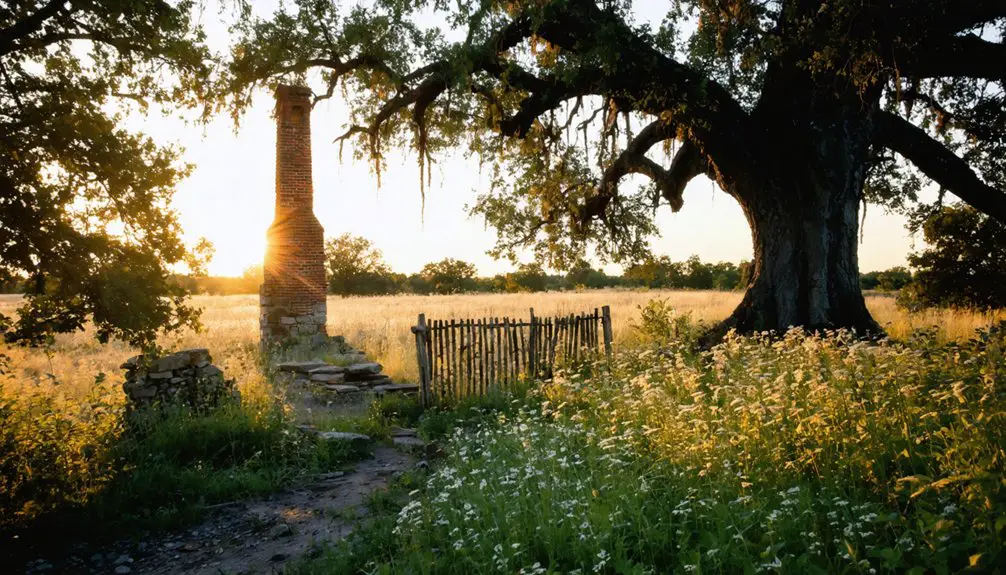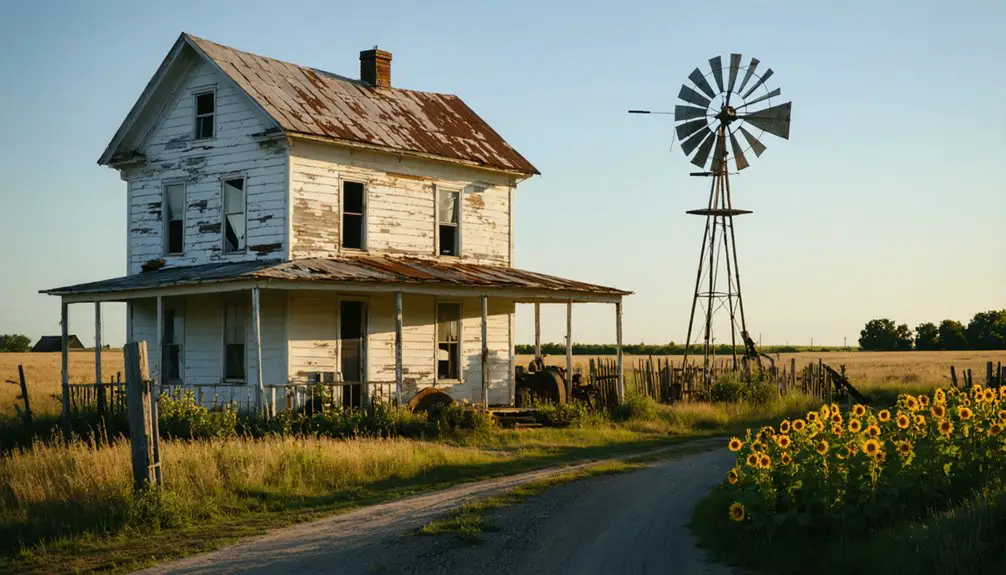You’ll find New Spring Place, Oklahoma near present-day Oaks, established in 1842 by Moravian missionaries following the Cherokee removal from Georgia. The settlement served as an essential educational center, running a boarding school that taught Cherokee students reading, writing, and geography. While the Civil War brought devastation in 1862, leading to its abandonment, the site’s limestone ruins and cultural significance tell a remarkable story of Cherokee resilience and educational achievement in Indian Territory.
Key Takeaways
- New Spring Place was established in 1842 near present-day Oaks, Oklahoma, as a relocation of the original Spring Place Mission from Georgia.
- The settlement became abandoned in 1862 during the Civil War after the death of missionary James Ward.
- Raiders and violence during the Civil War led to economic devastation, with 300,000 cattle stolen from the area.
- The site served as a Moravian missionary boarding school, educating Cherokee students in reading, writing, and U.S. geography.
- Located near the Illinois River, the settlement featured simple structures built from local limestone and wood before its abandonment.
Origins in Cherokee Territory
When Cherokee leaders extended an invitation to the Moravian Brethren from Salem, North Carolina, Spring Place Mission took root in 1801 along the Federal Road connecting Augusta to Nashville.
Under Cherokee leadership, this first formal school aimed to create an educated elite who’d help preserve their nation’s independence against land encroachment.
Cherokee leaders strategically established formal education to develop intellectuals who could defend their sovereignty from territorial threats.
The nonacquisitive Moravian influence proved significant, with missionaries like John Gambold and Anna Rosina Gambold dedicating themselves to education and hospitality.
You’ll find that approximately 114 Cherokee children received education there between 1804 and 1833, including prominent figures like Elias Boudinot and the sons of David Watie and Major Ridge.
This mission maintained the longest presence among missionary groups in Cherokee territory until the forced removal of 1838. Following removal, the mission established New Spring Place in Indian Territory in 1842. Tragedy struck when missionary James Ward was killed during Civil War conflicts in 1862.
From Georgia to Oklahoma: A Mission’s Journey
Following the forced Cherokee removal to Indian Territory, you’ll find that Moravian missionaries established New Springplace near present-day Oaks, Oklahoma in 1842 to continue their work with the displaced tribe.
The mission’s name intentionally honored its Georgia predecessor, where Moravians had successfully operated a school and church since 1801.
Just as they’d done in Georgia, the missionaries maintained their commitment to Cherokee education by establishing a boarding school that helped develop tribal leaders while preserving Cherokee cultural identity. Among the notable graduates was Elias Boudinot, who became editor of The Cherokee Phoenix newspaper.
The school educated twenty-one students in subjects ranging from reading and writing to U.S. geography and arithmetic.
Original Mission’s Relocation Story
The Spring Place Mission‘s remarkable journey from Georgia to Oklahoma stands as a tribute to the Moravian missionaries‘ enduring commitment to the Cherokee people.
When you trace their path, you’ll find that missionary challenges began intensifying in 1833 as Georgia citizens pressured the original mission to close.
After the Cherokee’s forced removal in 1838, the missionaries wouldn’t abandon their calling.
The mission’s dedication to educating Cherokee youth was evident through their work with influential leaders like Buck and John Ridge, who received their schooling at Spring Place.
Following their relocation, the missionaries established New Springplace in Oklahoma to continue their educational efforts.
Cherokee Education Continues West
Despite the upheaval of forced relocation, Cherokee education flourished after the tribe’s westward journey to Oklahoma Territory. You’ll find remarkable Cherokee resilience in how quickly they rebuilt their educational system, establishing eighteen public schools by 1843.
The educational evolution included the prestigious Cherokee Female Seminary, opened in 1851 near Tahlequah. This institution offered an ambitious curriculum including Greek and Latin among other rigorous subjects. The Spring Place missionaries had laid the foundation for Cherokee education back in 1804 in Georgia.
You can trace the roots of this success to pre-removal days when Moravian missionaries operated schools in Georgia. In Oklahoma, the Cherokee expanded their vision, creating an extensive system that included day schools and boarding facilities.
They maintained bilingual instruction using the Cherokee syllabary, achieving impressive literacy rates. The schools demonstrated sovereignty by welcoming students from other tribes, while incorporating both traditional knowledge and modern curriculum standards.
Moravian Educational Legacy
Moravian missionaries established a profound educational legacy through their work at New Springplace Mission, founded in 1842 near present-day Oaks, Oklahoma.
Their educational impact centered on empowering Cherokee youth with English literacy skills while supporting cultural preservation. You’ll find that the mission’s strategic focus on creating an educated Cherokee elite helped strengthen tribal sovereignty and resistance against land encroachments.
The school welcomed children from prominent Cherokee families, including those of David Watie and Major Ridge, who later became influential leaders. The program continued earlier work by John and Anna Gambold at the original Springplace location.
Prominent Cherokee leaders David Watie and Major Ridge entrusted their children’s education to New Springplace Mission, shaping the next generation of tribal leadership.
You can trace the mission’s commitment to Cherokee autonomy through its curriculum, which balanced religious instruction with practical subjects. The mission maintained strict admission standards for converts, reflecting their dedication to thorough religious education.
Despite Civil War disruptions and eventual closure, the Moravians’ dedication to Cherokee education left an indelible mark on the tribe’s ability to navigate challenging political landscapes.
Life at the Mission Settlement
If you’d visited New Spring Place Mission in the 1840s, you’d have found Cherokee students attending daily classes and worship services while living in simple dormitory accommodations alongside Moravian instructors.
The mission settlement maintained its own farm and gardens to support residents, with students participating in agricultural work between their studies.
You’d have witnessed regular trading interactions between mission residents and neighboring Cherokee communities, who exchanged goods and maintained social connections through church gatherings and community events.
Daily Education and Worship
When New Springplace Mission opened its doors, it established an extensive educational and worship program modeled after the original 1801 Springplace mission in Georgia.
You’d find the educational practices deeply intertwined with spiritual teachings, as students began their days with communal prayers before moving into literacy lessons and practical skills training. The mission’s curriculum focused on developing Cherokee leaders who could defend their nation’s interests while maintaining strong Christian values.
Within the boarding facilities, you’d witness daily worship integration through Moravian hymn singing, scripture study, and regular prayer services.
The mission’s commitment to balancing academic instruction with religious activities created a unique environment where Cherokee children could develop both intellectually and spiritually, preparing them for leadership roles within their community.
Mission Living Conditions
Beyond the daily rhythms of education and worship, life at New Springplace Mission centered around communal living in simple but purposeful structures. You’d find dormitories built from local limestone and wood, where Cherokee children boarded alongside missionary families in close quarters.
The mission architecture reflected both traditional Cherokee influences and practical frontier adaptations, though limited insulation meant you’d endure harsh winters and sweltering summers.
You’d share daily tasks with others, from farming corn and beans to maintaining buildings. While the communal living fostered tight bonds, you’d face significant challenges – basic medical care, crowded conditions, and occasional food shortages.
During epidemics or Civil War disruptions, you’d rely on community knowledge and mutual support to survive, with the nearby cemetery bearing silent witness to the harsh realities of frontier mission life.
Community Relations and Trade
Located strategically near the Illinois River, New Springplace Mission thrived as an essential hub of trade and cultural exchange between Cherokee and European-American communities.
You’d find missionaries and Cherokee traders working side by side at the mission’s trading posts and farms, creating lasting economic partnerships that sustained both communities.
The Moravians earned unique trust among Cherokee leaders, becoming one of few denominations recognized as government agents.
You’ll notice how they embraced Cherokee language and customs while teaching Christianity, fostering genuine cultural exchange.
Chief John Ross and other Cherokee leaders supported the mission through book donations and farm partnerships, while their children received education there.
This mutual respect helped ease tensions between Cherokee communities and settlers until federal policies like the Dawes Act disrupted these established relationships.
Civil War Disruption and Changes
During the Civil War, the New Spring Place region endured devastating disruption as irregular partisan bands from both Union and Confederate forces terrorized civilians throughout Indian Territory.
You’ll find evidence of widespread tribal suffering in the mission’s abandonment after Cherokee missionary James Ward’s death by Pin Indians and federal troops in 1862.
The refugee crisis reached staggering proportions, with 7,000 displaced people surrounding Fort Gibson by 1863, while another 15,000 Confederate civilians endured harsh conditions near the Red River.
Thousands of desperate refugees sought shelter at Fort Gibson and Red River, fleeing the devastating violence of civil war.
The economic ruin was catastrophic – raiders stole 300,000 head of cattle, devastating tribal wealth.
The war’s impact on New Spring Place proved permanent, as displacement shattered the community and left the Moravian mission’s cemetery in need of extensive rehabilitation by the 1870s.
Notable Mission Leaders and Families

The Moravian missionaries who established New Springplace Mission in 1842 brought with them a legacy of dedicated leadership from their original Georgia settlement.
You’ll find the Ward family at the heart of the mission, with James Ward serving until his tragic murder in 1862, leaving his wife to care for their twin boys.
Among the notable missionary families, the Gambolds made lasting contributions, with Anna Rosina’s expertise in education and botany shaping the mission’s direction.
The Ross family and Sophia Reuter strengthened the educational legacy through their dedication to teaching Cherokee youth.
These families lived modestly, often in poverty, while fostering cultural exchange and providing formal education.
Their commitment extended beyond basic schooling, as they helped cultivate an educated Cherokee elite through their boarding school program.
The Mission’s Final Years
As tensions mounted during the Civil War, New Springplace Mission’s role as a peaceful sanctuary crumbled amid escalating guerrilla warfare throughout Oklahoma Territory.
You’ll find that mission challenges intensified in 1862 when “Pin Indians” murdered Cherokee missionary James Ward, forcing his family to flee.
Even Rev. Gilbert Bishop couldn’t escape the turmoil, falling captive to federal troops.
Despite the community’s resilience in rebuilding after the war, including cemetery restoration in the 1870s, the mission faced mounting pressures.
By the late 19th century, allotment policies and Cherokee government changes threatened the mission’s sustainability.
In 1898, the Moravians transferred their work to the Evangelical Danish Lutheran Church, ending nearly a century of influence in Cherokee religious and educational life.
Modern-Day Historical Site

Located near the Oaks community in present-day Oklahoma, New Spring Place Mission stands as a tribute to early Cherokee-Moravian cultural exchange, though few original structures remain.
You’ll find historical markers commemorating this significant site, where cultural heritage lives on through the Oaks Indian Mission‘s continued operations.
The mission’s cemetery, rehabilitated in the 1870s, serves as a physical reminder of the interracial cooperation between Moravian missionaries and Cherokee converts.
While the original 160-acre property was reduced to just four acres during the Dawes Commission’s land redistribution, historical preservation efforts maintain the site’s significance.
Today, you can explore this representation of Cherokee educational advancement and religious cooperation, where Chief John Ross once supported the first formal Cherokee school’s continuation in Indian Territory.
Frequently Asked Questions
What Traditional Cherokee Ceremonies Were Practiced at New Springplace?
You’ll find traditional Cherokee ceremonies at New Springplace included the New Moon of Spring, Green Corn, Ripe Corn, Great New Moon, and Friends Made ceremonies, all preserving sacred fire and water practices.
How Many Students Attended the Mission School at Its Peak?
While you might expect higher numbers from a mission school, historical enrollment trends show that New Springplace reached its peak attendance with just 21 students pursuing their education under Moravian teachers.
What Crops and Livestock Were Raised at the New Springplace Settlement?
You’ll find they cultivated wheat and corn primarily, while also growing rye grass and other grains. Their livestock management focused on beef cattle herds, dairy cows, and horses for transportation and farm work.
Did Any Cherokee Language Materials Survive From the New Springplace Mission?
You won’t find definitive proof of surviving Cherokee language materials from New Springplace Mission. While Moravian missionaries influenced Cherokee preservation, historical upheavals and the mission’s English-focused education likely scattered or destroyed such documents.
What Artifacts Have Archaeologists Recovered From the New Springplace Site?
Through artifact analysis and careful excavation techniques, you’ll find stone chips, pottery fragments, glass, metal nails, brick hearth remains, structural foundations, and iron objects from both Native American and post-contact periods.
References
- https://en.wikipedia.org/wiki/List_of_ghost_towns_in_Oklahoma
- https://www.okhistory.org/publications/enc/entry?entry=OA003
- https://www.georgiahistory.com/ghmi_marker_updated/springplace-mission/
- https://www.hmdb.org/m.asp?m=12328
- https://www.okhistory.org/publications/enc/entry?entry=MO018
- https://www.youtube.com/watch?v=Qjp_WPEhktA
- https://www.georgiaencyclopedia.org/articles/history-archaeology/indian-missions/
- https://sherryshindelar.com/blog/30-Moravians-Missionaries-to-the-Cherokee
- https://digitalcommons.unl.edu/cgi/viewcontent.cgi?article=1214&context=docedit
- https://www.okhistory.org/publications/enc/entry?entry=CH018



